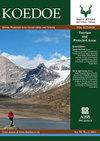Ecology of palustrine wetlands in Lesotho: Vegetation classification, description and environmental factors
IF 1.1
4区 环境科学与生态学
Q3 BIODIVERSITY CONSERVATION
引用次数: 11
Abstract
Palustrine wetlands, which cover about 6% of the earth’s land surface, are among the most ecologically sensitive ecosystems and very important globally because of their unique role in biogeochemical cycles (Junk et al. 2013; Mitsch & Gosselink 2015). Because they support azonal vegetation that is distinct from the surrounding vegetation (Mucina & Rutherford 2006; Sieben et al. 2016), wetlands are ecological ‘islands’ within terrestrial environments in different landscapes across the globe. The distinction results from the prolonged water logging that causes oxygen deficiency (hypoxia) or its total absence (anoxia) in the wetland soil, with subsequent chemical changes in soil characteristics (Gopal 2015; Mitsch & Gosselink 2015). Mucina and Rutherford (2006) observed that the presence of water, whether seasonal or permanent, is the primary factor in creating wetland habitats and associated vegetation. Nonetheless, it is not wetness per se that primarily influences the geochemistry and morphology of wetland soils, but rather the anaerobic conditions that result from prolonged soil saturation or flooding (Collins 2005; Kotze et al. 1996). The description and classification of wetland vegetation is important for water resource management and biodiversity conservation as it provides an understanding of the wetland vegetation–environment relationships and information to interpret spatial variation in plant communities. This study discusses the vegetation of the palustrine wetlands of Lesotho based on a phytosociological approach. Data on vegetation and various environmental variables were collected using the Braun-Blanquet method and a standardised protocol developed for environmental information of wetlands in South Africa. The data were analysed mainly by clustering and ordination techniques. Twenty-two communities were found by the classification of the wetland vegetation. These communities were found to be diverse in terms of species richness. The ordination revealed that the wetland vegetation is mainly influenced by altitude, longitude, slope, soil parent material, landscape, inundation, potassium content, soil texture, total organic carbon, nitrogen, electrical conductivity and latitude. Regarding species composition and diversity, plant communities in the Highlands were more diverse and were distinctively different from those in the Lowlands. High-altitude communities were also found to be dominated mainly by C3 plants, while those at low altitudes exhibited the dominance of C4 species. Some communities were either restricted to the Highlands or Lowlands but others exhibited a wide ecological amplitude and occurred over an extensive altitudinal range. The diversity of most of the wetlands, coupled with their restricted habitat, distribution at high altitudes and their role in supplying ecosystem services that include water resources, highlights the high conservation value associated with these wetlands, particularly in the face of climate change and loss of biodiversity.莱索托河口湿地生态学:植被分类、描述与环境因子
沼泽湿地约占地球陆地面积的6%,是生态最敏感的生态系统之一,由于其在生物地球化学循环中的独特作用,在全球范围内非常重要(Junk et al. 2013;Mitsch & Gosselink 2015)。因为它们支持与周围植被不同的地带性植被(Mucina & Rutherford 2006;Sieben et al. 2016),湿地是全球不同景观中陆地环境中的生态“岛屿”。这种区别是由于长时间的淹水导致湿地土壤缺氧(缺氧)或完全缺氧(缺氧),随后土壤特征发生化学变化(Gopal 2015;Mitsch & Gosselink 2015)。Mucina和Rutherford(2006)观察到,水的存在,无论是季节性的还是永久性的,都是创造湿地栖息地和相关植被的主要因素。然而,主要影响湿地土壤地球化学和形态的不是湿度本身,而是长期土壤饱和或洪水造成的厌氧条件(Collins 2005;Kotze et al. 1996)。湿地植被的描述和分类对水资源管理和生物多样性保护具有重要意义,为理解湿地植被与环境的关系和解释植物群落的空间变化提供了信息。本研究基于植物社会学的方法讨论了莱索托河口湿地的植被。利用Braun-Blanquet方法和为南非湿地环境信息制定的标准化协议收集了植被和各种环境变量的数据。数据分析主要采用聚类和排序技术。通过对湿地植被的分类,共发现22个群落。这些群落在物种丰富度方面具有多样性。排序结果表明,湿地植被主要受海拔、经度、坡度、土壤母质、景观、淹没、钾含量、土壤质地、总有机碳、总氮、电导率和纬度的影响。在物种组成和多样性方面,高原地区的植物群落多样性明显高于低地地区。高海拔群落以C3植物为主,低海拔群落以C4植物为主。有些群落局限于高地或低地,而另一些群落则表现出广泛的生态幅度,分布在广泛的海拔范围内。大多数湿地的多样性,加上它们有限的生境、分布在高海拔地区以及它们在提供包括水资源在内的生态系统服务方面的作用,突出了这些湿地的高度保护价值,特别是在面对气候变化和生物多样性丧失的情况下。
本文章由计算机程序翻译,如有差异,请以英文原文为准。
求助全文
约1分钟内获得全文
求助全文
来源期刊

Koedoe
BIODIVERSITY CONSERVATION-
CiteScore
3.30
自引率
0.00%
发文量
10
审稿时长
20 weeks
期刊介绍:
Koedoe, with the subtitle ''African Protected Area Conservation and Science'', promotes and contributes to the scientific (biological) and environmental (ecological and biodiversity) conservation practices of Africa by defining the key disciplines that will ensure the existence of a wide variety of plant and animal species in their natural environments (biological diversity) in Africa.
 求助内容:
求助内容: 应助结果提醒方式:
应助结果提醒方式:


